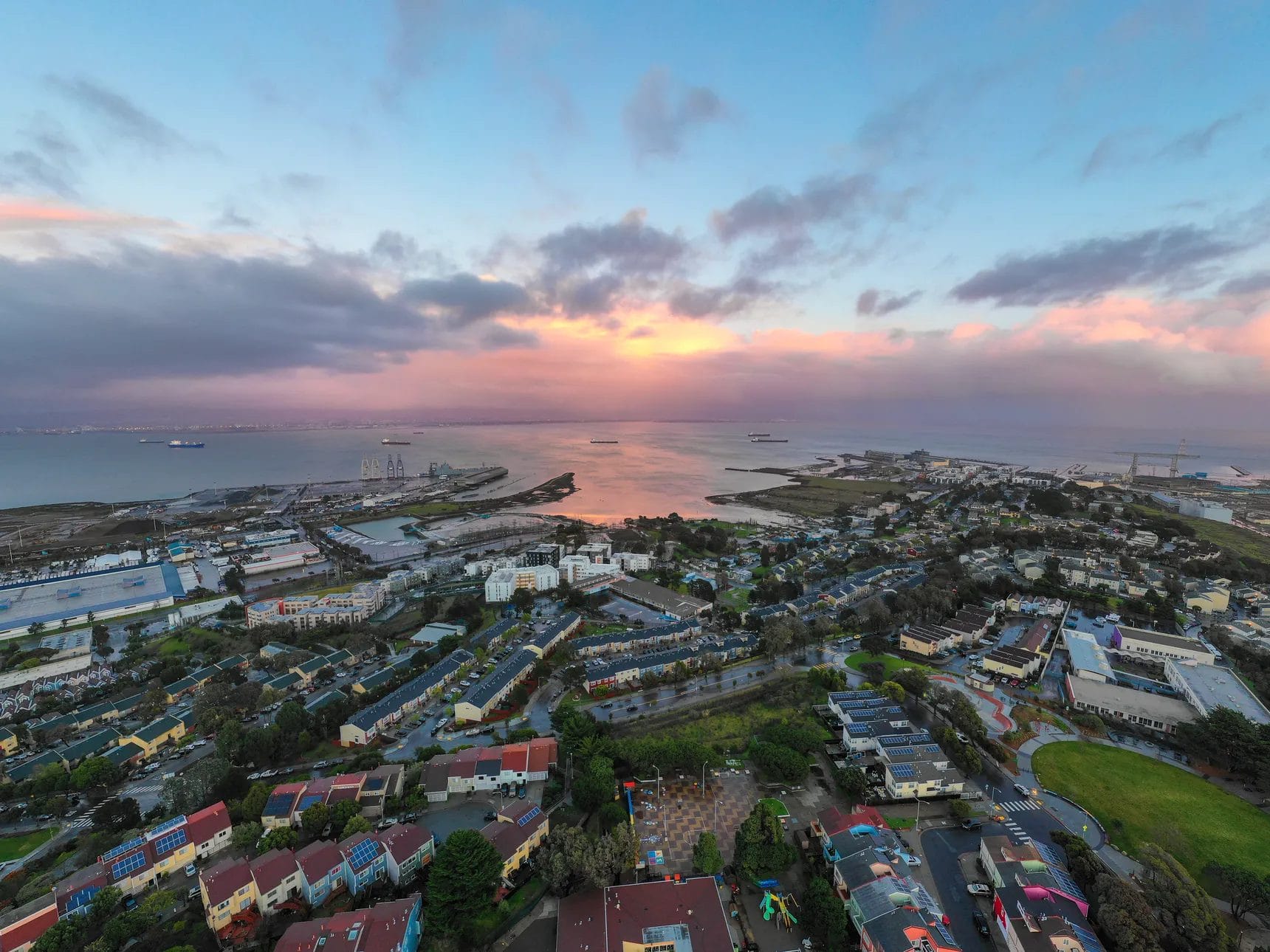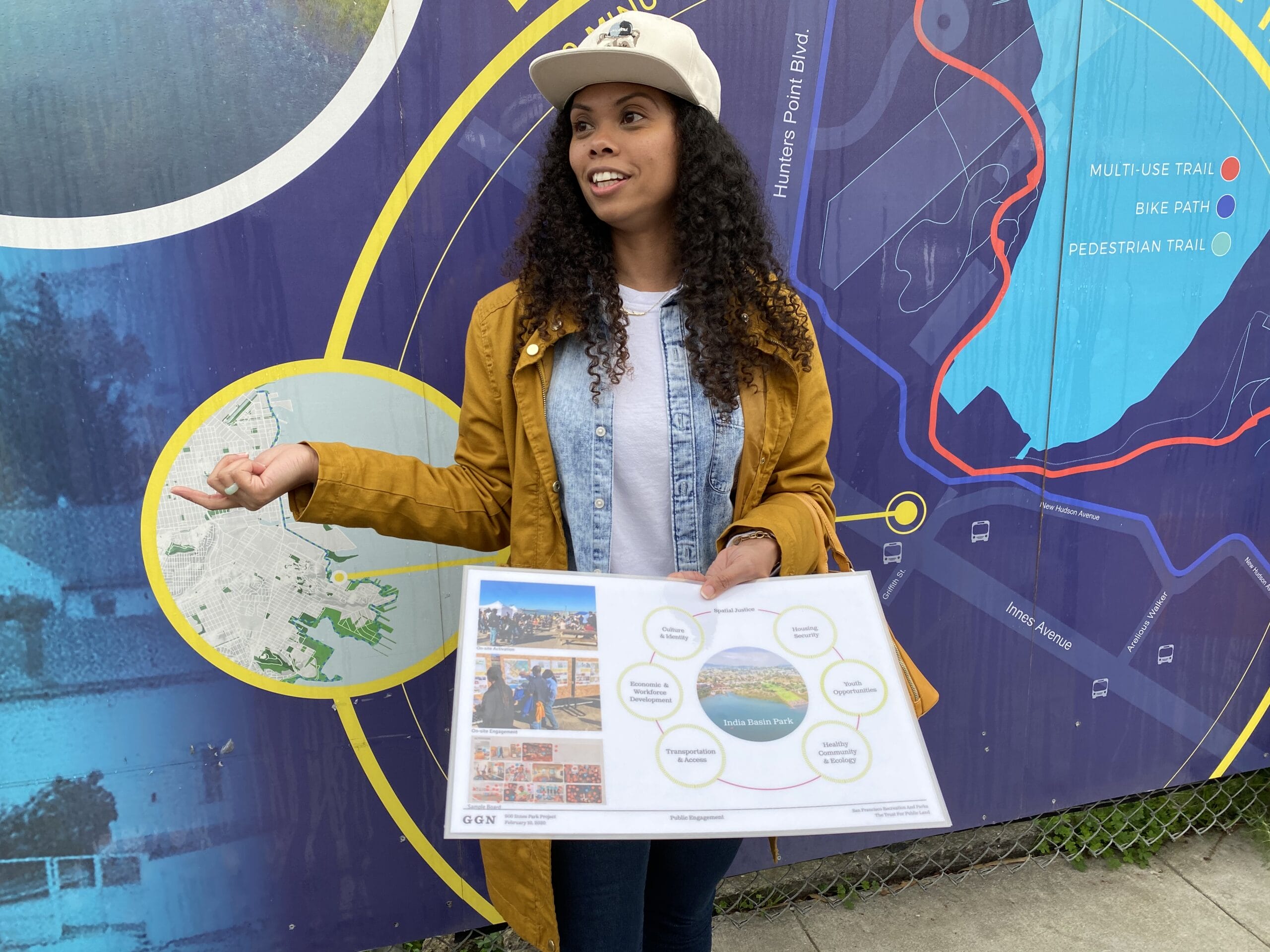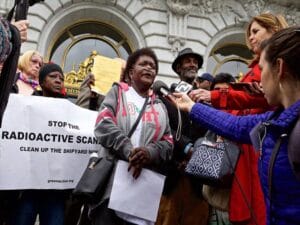Bayview–Hunters Point: A Historical Overview
The steep streets of Bayview–Hunters Point rise to a crest. From here you can see the light glimmer off the San Francisco Bay on one side and a rush of cars on the Bayshore Freeway on the other. From this vantage point, the neighborhood feels like an island, historically treated as such. Built around the World War II shipbuilding industry, Bayview–Hunters Point became a predominantly Black neighborhood isolated by decades of discrimination.
Jacqueline Bryant (above) recalls walking these streets as a teenager, distributing voter information for the A. Philip Randolph Institute (APRI). “They would offer us 20 bucks to work on the weekend and go door to door handing out flyers,” she remembers. Today, Bryant continues this tradition of advocacy by working to create a waterfront park that addresses historic injustices.

An aerial view of the Bayview–Hunters Point neighborhood. Photo: Shutterstock
Jacqueline Bryant’s Story
Jacqueline Bryant’s father was James Bryant, a station agent and union leader at the San Francisco Municipal Transportation Agency who worked to provide opportunities for people of color. He built relationships with community leaders and elected officials, and brought his daughter into the fold early. “He would bring us out, and we’d have signs in our hands, walking right next to folks like Nancy Pelosi and Dianne Feinstein,” says Bryant.
Raised on activism, Bryant grew into a leader in her community. Today, she is the executive director of APRI San Francisco. This is one of four partner organizations collaborating on India Basin Waterfront Park. Along with APRI San Francisco, the project is being implemented by the San Francisco Recreation and Park Department (SFRP), Trust for Public Land (TPL), and the San Francisco Parks Alliance. Bryant sees her efforts as part of a long movement for racial equality and economic justice through community engagement and civic participation.
The Legacy of the Big Five
In Bayview, this fight started with the Big Five. Commonly identified as Elouise Westbrook, Ruth Williams, Bertha Freeman, Osceola Washington, and Julia Commer, the Big Five are legendary for their advocacy on behalf of decent housing, education, job opportunities, and a healthy environment.
Bryant says their efforts “lay groundwork for community leaders to say, ‘We don’t just take whatever they give us. We have to demand change. We actually have to fight for our rights to survive and live and be here.’”
Donate to support our work in California, including India Basin Waterfront Park.
That fight continues with Bryant’s work today. She says, “I hear a lot of stories about the power, the impact that those women had . . . I’m one of those young people that are carrying the torch of the work that they did early on.”
Continuing the Fight
Others have also carried that torch. As described in From the Ground Up, community activists such as Marie Harrison and Tessie Ester (see below) led the 1990s neighborhood movement for environmental justice, combating local toxic pollution. They initiated programs placing youth leaders at the movement’s center. Espanola Jackson, another Bayview activist, advanced job training programs and local hiring policies, creating national models for neighborhood economic opportunity.
Today, these women’s achievements inform the transformation of 64 acres along the last undeveloped piece of the San Francisco Bay shoreline. Following their legacy, Bryant ensures this development benefits long-term residents. She believes this is “our time to have a voice in a city process where we don’t normally have a voice. Here’s our opportunity to dream really big.”
The Equitable Development Plan
That collective dream has created San Francisco’s first-ever Equitable Development Plan. Led by Bryant and authored by residents and community groups, the plan outlines commitments for supporting local arts and culture, workforce and business development, transportation, health and ecology, opportunities for youth, and housing security.
If successful, the plan can help to restore trust that has been eroded by a history of unfulfilled promises and provide a guide to community-based development. “If you’re not hearing what the community has said for years, for generations, then you’re not really able to address some of the concerns that this community has in trusting the government,” Bryant says.
Community Engagement
To make sure community voices are heard, TPL supported the process that created the Equitable Development Plan. Now, they’re working to ensure the plan’s implementation. As Terence Wu of TPL’s Bay Area Parks for People team says, “With community engagement, consistency is really important so that people see the same faces and build trust.”
Ultimately, Bryant believes the plan will be measured by how well it delivers.“ This community has had a history of broken promises, she says. “What’s most important to me is making sure investments make it into the community.”
The First Phase of Construction
The first phase of construction is now underway. When complete, the park will provide access to the water for a community that has been historically cut off from it. Features will include a beach, restored tidal landscape, playgrounds, fitness areas, a history center in a converted shipyard cottage, a new boathouse, pier, and a recreational dock for kayaking and fishing.
Additionally, there will be a makers shop, classroom, food pavilion for community gatherings, and multimodal trails connecting to the 350-mile Bay Trail. An incubator kitchen for local food entrepreneurs is also planned.
Events at the Park
Already, the site is welcoming neighbors. Construction is phased to keep the park accessible as it’s built. Partner organizations have created events to engage the community and build excitement. APRI has taken the lead on hosting a fall festival with a pumpkin patch, kayaking, local vendors, and free meals. Holiday in the Park featured a free toy giveaway, arts and crafts, and a photo booth.
There have been teen nights, youth workshops, and small-business markets. A “Community Innovation Lab,” allows locals to borrow a laptop or tablet and access free tech support and Wi-Fi.
Free Construction Training Programs
Free construction training programs are proceeding at APRI in partnership with SFRP and the San Francisco Office of Economic and Workforce Development. Sharmila Kittrell was among the first professionals trained. She spoke at her graduation ceremony, which was appropriately held at the Southeast Community Center, a facility the Big Five were instrumental in advocating for. In her speech, Kittrell described herself as a Black woman, single mother, and a person with a record—making it difficult to get a job. But since the training, she’s been hired to work on several construction sites.
“Many believe these projects do not produce individuals that are productive to society, but I’m here to prove them wrong.”
—Sharmila Kittrell
Beyond benefits and a pension, she’s grateful to “feel I have a purpose and a career my children can be proud of.” Her classmate Yoshida Ellis Pitts felt the same, adding, “My family is proud of me, and I am proud of myself.” On behalf of her entire cohort, Kittrell shared, “My classmates and I stand here today as examples of being blessed with the opportunity to defy the odds and prove to society that, if given an honest chance, we all have the strength and capabilities to overcome any hardships that were placed in front of us.”

Sharmila Kittrell (center) and Yoshida Ellis Pitts (second from right) at their graduation ceremony from the workforce development program. Photo: San Francisco Recreation and Park Department
Realizing Generations of Hope
As Kittrell and Pitts demonstrate, the community engagement process hasn’t only provided a way for the people of Bayview–Hunters Point to weigh in on the typical amenities of a park, but it’s also created opportunities for locals to change what parks do for their communities. In this way, India Basin Waterfront Park could at last realize the hopes of generations of women in Bayview–Hunters Point who have fought for equality.
Jacqueline Bryant is determined to transform decades of effort into a new reality for Bayview–Hunters Point, saying, “We’re going to make sure these investments make it into the community. We’re going to make sure we can show what impact and change we’re having, and we’re going to create these opportunities at every step of the way.”
Read the First Part of this Two-Part Series
This is the second part of a two-part series written by Alison Sant, author of From the Ground Up: Local Efforts to Create Resilient Cities (Island Press, 2022). Part 1 features a description of the Big Five, and the public art piece, Lady Bayview created by artist Raylene Gorum to honor the community activists of Bayview–Hunters Point.

Donate to become a member, and you’ll receive a subscription to Land&People magazine, our biannual publication featuring exclusive, inspiring stories about our work connecting everyone to the outdoors.



 Dr. Espanola Jackson advocated for local jobs, affordable housing, and small business opportunities in Bayview–Hunters Point. She helped create the Local Hiring Policy for Construction, implemented by CityBuild training programs. Mayor Ed Lee proclaimed February 9 as Dr. Espanola Jackson Day, and in 2012, she received the San Francisco Human Rights Commission’s first Hero Legacy Award for her contributions to human rights advocacy.
Dr. Espanola Jackson advocated for local jobs, affordable housing, and small business opportunities in Bayview–Hunters Point. She helped create the Local Hiring Policy for Construction, implemented by CityBuild training programs. Mayor Ed Lee proclaimed February 9 as Dr. Espanola Jackson Day, and in 2012, she received the San Francisco Human Rights Commission’s first Hero Legacy Award for her contributions to human rights advocacy.